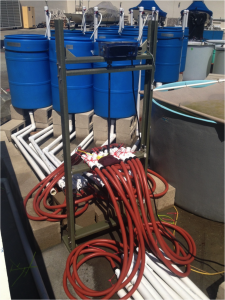A few years back I posted about a set of Arduino libraries I wrote to allow an Arduino with an attached clock to predict the tides for a coastal site. In that post, I showed a variation on the theme that had a motor-driven rack that transited up and down in time with the tide.
Now Jeremy Long and I have published an open access paper in the journal PeerJ (external link) describing our use of that tide-predicting-motorized-rack, which we called the Tide Height Control system. We used the THC system to recreate real tide cycling in a set of deep lab aquaria where marsh plants (Spartina foliosa) were being raised. By changing the height of the potted marsh plants inside a set of aquaria, we could simulate the submersion conditions for different real-world shore heights. Plants higher on the shore spend less time in the water than plants lower on the shore, and we observed reduced plant growth higher on the shore, even over a small 0.4m shore height difference.

The motorized rack moved up and down over a 0.84m (2 ft) range of the tide, when the real world tide was between +2.07m and +1.23m. The drains of each deep barrel were attached to hoses that run over the moving rack of the THC system, so that as the drain hoses raised and lowered, the water levels in the barrels would rise or fall to match the height of the moving rack. This meant that water would drain away from the soil in the plant pots at a rate similar to what would occur in the field, slowly exposing the plant stems and root systems, and then re-submerging them when the tide rose again.
PeerJ is a completely open access journal, so you can read our paper, or any of the other papers there, for free. The paper includes links to the permanent online repositories for the Arduino code, instructions and drawings for building a THC rack, R code used in the analysis of the data, and of course the data for the paper. There are also “live” repositories on GitHub for the tide prediction libraries and the code used to run the THC rack itself.
It’s worth noting that the Arduino tide prediction portion of this project could be put to many other research uses, particularly if you have lab or field experiments where some action or recording needs to take place at a particular phase of the tide. For instance, you could program an Arduino to activate a camera and only take pictures at high tide or low tide. Please feel free to adapt any of the ideas in presented in this work for your own purposes, and if you do, you can cite our work as follows:
Miller LP, Long JD. (2015) A tide prediction and tide height control system for laboratory mesocosms. PeerJ 3:e1442 https://dx.doi.org/10.7717/peerj.1442